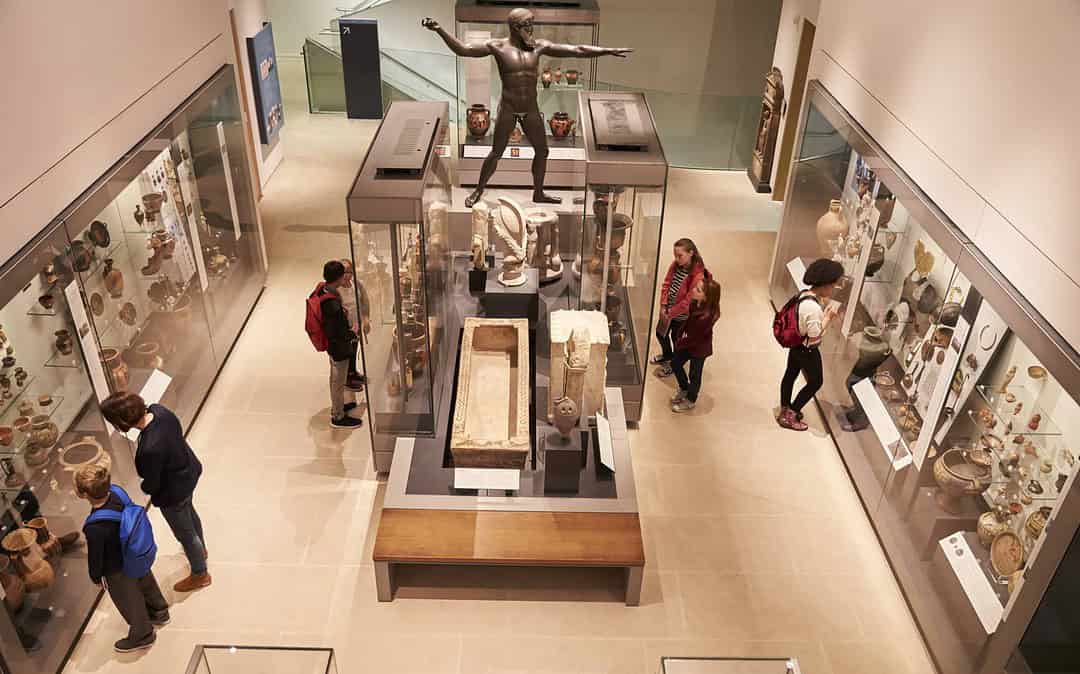Creating a museum exhibit is no small feat. It’s a complex blend of art, science, and storytelling, woven together under the pressure of educational objectives, budget constraints, and space constraints.
So how do you create a museum exhibit project? The process begins with a clear understanding of your objectives. What do you want visitors to learn, feel, or experience? From there, you’ll need to:
- Know your audience
- Define the exhibit’s theme and purpose
- Curate content and artefacts
- Design the physical layout
- Mount exhibit items securely and stylishly
- Integrate advanced technology
- Develop a marketing plan to generate excitement
How to design a museum exhibit
1. Know your audience
Start by identifying the demographic characteristics of your typical visitors, such as age range, educational background, interests, and cultural heritage. This understanding will inform every other decision, from the complexity of the information presented to the interactive elements you might include.
For example, exhibits aimed at children often incorporate tactile experiences and vibrant visuals to stimulate learning and curiosity, while those intended for adults might delve deeper into historical or technical details.
Utilise visitor surveys, previous attendance data, and feedback to refine your audience profile. By empathising with your audience’s perspective and needs, you can create an exhibit that is not only informative but also emotionally and intellectually engaging.
2. Define the exhibit’s theme and purpose
When defining the theme and purpose of your exhibit, it’s crucial to ensure relevance to both the local and national context. Australia’s rich history and diverse ecosystems, for instance, provide ample opportunities for educational themes ranging from the story of the First Australians, through colonial history, to contemporary issues like biodiversity conservation.
Themes should be chosen not only for their educational value but also for their ability to resonate on a personal level with visitors. For exhibits dealing with sensitive or significant cultural content, such as those involving Indigenous heritage, it’s essential to work collaboratively with Indigenous cultural advisors to ensure respectful and accurate representation.
3. Curate content and artefacts
Curating content and artefacts is a meticulous process that involves selecting, organising, and interpreting objects and information to support your exhibit’s theme and educational goals.
Start by identifying key artefacts, documents, and multimedia that are essential to the narrative. Each piece should contribute to the overarching story you wish to tell. Consider not only the historical significance of each item but also how it engages the senses or emotions of the viewer.
Interactive elements (e.g., digital touchscreens, hands-on activities) can enhance engagement and accessibility. This thoughtful approach to curation will enrich the visitor’s experience and deepen their understanding of the subject matter.
Curating content also means choosing artefacts that tell a compelling story of Australia’s natural history, technological achievements, or artistic expressions. For instance, an exhibit on Australia’s natural environment might include interactive digital displays that show the impact of climate change on the Great Barrier Reef alongside artefacts like coral samples or historical climate data.
4. Design the physical layout
This design should facilitate a logical and engaging flow that guides visitors through the narrative or thematic journey you have planned. Consider the use of space to create a dynamic experience – areas for reflection, interactive zones, and detailed information panels can all play a part.
The layout should also be accessible to all visitors, including those with disabilities. This might involve wide pathways for wheelchair access and varying heights of displays to accommodate both children and adults.
In Australia, this also means incorporating signage with dual language information, particularly for exhibits involving Indigenous cultures or bilingual communities.
5. Mount exhibit items securely and stylishly
Ensuring that artefacts are displayed securely and attractively is vital for both their preservation and aesthetic appeal. Standoff fixing systems are an excellent choice for mounting items since they not only securely hold the artefacts in place but also add a modern and unobtrusive look to the display.
These systems can be used for a variety of materials, including glass, metal, and wood, allowing for flexibility in how items are presented. They also make it easy to change out items without significant disruption to the exhibit, facilitating updates and maintenance.
6. Integrate advanced technology
This can include augmented reality (AR) experiences that bring static displays to life, touchscreens that provide in-depth information at a touch, and apps that offer guided tours or additional content.
For example, an app could provide visitors with background information on Australian Indigenous art as they view each piece. Virtual reality (VR) stations can also transport visitors to different times or remote locations, offering immersive experiences that are particularly appealing to younger audiences and tech-savvy visitors.
7. Develop a marketing plan to generate excitement
A solid marketing plan is essential to attract visitors to your new exhibit. This should include traditional media such as print and broadcast, as well as digital marketing strategies like social media, email newsletters, and online advertising.
Creating engaging content such as behind-the-scenes videos, curator interviews, and sneak peeks of the exhibit can generate buzz and anticipation. Partnering with tourism boards, educational institutions, and cultural organisations can also help reach broader audiences.
In Australia, engaging with local community groups, especially those related to the exhibit’s content, can foster community involvement and support.
Frequently Asked Questions
What makes a good museum?
A good museum effectively engages and educates visitors through well-curated exhibits, interactive and accessible content, and by showcasing culturally and historically significant artefacts. It should cater to diverse audiences, maintain high standards for artefact preservation, and actively connect with the community through educational programs and events.
How can I make my museum more interesting?
To make your museum more interesting:
- Introduce Interactive Exhibits: Engage visitors with hands-on activities and interactive technology.
- Rotate Exhibits Regularly: Keep the content fresh and encourage repeat visits.
- Host Special Events: Offer workshops, lectures, and themed nights to draw different crowds.
- Collaborate: Work with local artists, historians, and other museums to bring unique exhibits and programs.
How do museums attract visitors?
Museums attract visitors by:
- Effective Marketing: Using both digital and traditional marketing strategies to reach a wide audience.
- Community Engagement: Partnering with local schools, community groups, and businesses to build strong local support.
- Unique Offerings: Providing special exhibitions and unique visitor experiences.
- Membership Programs: Creating value through memberships that offer benefits like exclusive events and discounts.
- Tourism Partnerships: Collaborating with tourism boards and travel agencies to feature in travel packages.
How do museums decide what to display?
Museums decide what to display based on:
- Relevance to Mission: Ensuring exhibits align with the museum’s mission and objectives.
- Visitor Interest: Considering what is likely to engage and attract the target audience.
- Cultural and Historical Significance: Choosing artefacts that offer significant insight or value.
- Artefact Condition: Assessing whether they can properly preserve and display the artefacts.
- Curatorial Expertise: Relying on the knowledge and judgement of curators to select and arrange exhibits thoughtfully.
With FIX standoffs, you can enhance the visual appeal of your displays
Museums play a crucial role in enriching our lives and communities. They safeguard our history and culture, providing a tangible connection to the past and a deep understanding of various perspectives that shape our world. As centres of education and enjoyment, museums help to foster curiosity and lifelong learning among visitors of all ages.
If you’re involved in museum curation or management and are looking for ways to improve the presentation of your exhibits, consider using FIX standoffs. These high-quality mounting systems not only secure your artefacts and displays efficiently but also add a touch of elegance to your presentations. With FIX standoffs, you can create visually appealing setups that captivate your audience and make each visit memorable.
Start providing an even more engaging and enlightening experience for all your visitors today.
Phone
We deliver standoff fixings to homeowners, designers, and commercial business owners across the world. Whether you’re in Australia or overseas, we have the architectural hardware to fit your needs.

